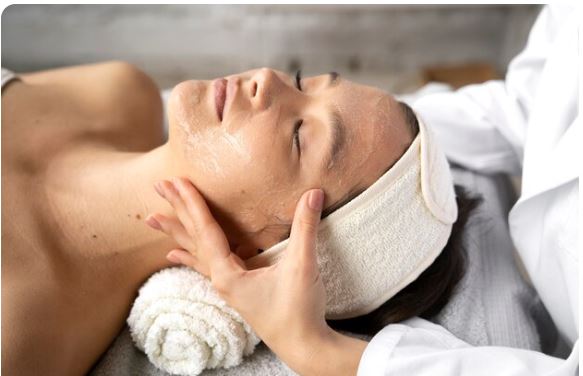Chemical peel treatment is a popular skincare procedure that helps improve the texture and appearance of the skin. It involves applying a Chemical peel treatment to the skin, which causes controlled peeling of the outer layers. This process encourages the growth of new skin that looks smoother, healthier, and more radiant. Chemical peels can be used on the face, neck, and hands, offering a variety of benefits for different skin concerns.
Types of Chemical Peels
There are three main types of chemical peels, each designed for specific skin needs.
Superficial Peels
Superficial peels are mild and target the outer layer of the skin. They are ideal for improving minor skin imperfections, such as uneven skin tone, mild acne scars, and fine lines. The recovery time is short, usually lasting a few days.
Medium Peels
Medium chemical peels penetrate deeper into the skin and are suitable for treating moderate wrinkles, pigmentation issues, and sun damage. These peels may require a longer recovery period of about one to two weeks.
Deep Peels
Deep peels are the strongest type and reach the deeper layers of the skin. They are effective for severe skin problems, including deep wrinkles, significant scarring, and age spots. Deep chemical peels require careful supervision by a professional, and recovery can take several weeks.
Benefits of Chemical Peel Treatment
Chemical peel treatment provides multiple benefits for the skin. It helps reduce fine lines and wrinkles, improves skin tone, and enhances overall skin texture. Peels can also treat acne and minimize acne scars. Additionally, chemical peels promote collagen production, which supports skin elasticity and firmness. Regular treatments can make the skin look youthful and refreshed.
Who Can Get Chemical Peels
Chemical peel treatment is suitable for most people who want to improve their skin’s appearance. Individuals with mild to moderate skin concerns, such as uneven tone, wrinkles, or acne scars, can benefit from chemical peels. However, people with certain medical conditions, active skin infections, or very sensitive skin should consult a dermatologist before undergoing treatment.
The Procedure of Chemical Peel Treatment
Chemical peel treatment is usually done in a professional clinic by a trained dermatologist or skincare specialist. The skin is first cleansed to remove dirt and oil. The chemical solution is then applied evenly on the targeted area. The solution works to peel off the damaged skin layers over time. After the peel, the skin is treated with soothing creams or serums to aid healing and reduce discomfort.
Recovery After Chemical Peel
Recovery after a chemical peel depends on the type and depth of the peel. Superficial peels may result in slight redness and flaking for a few days. Medium peels may cause redness, swelling, and peeling for one to two weeks. Deep peels often require longer healing time and careful post-treatment care. During recovery, it is important to protect the skin from sun exposure and follow the dermatologist’s instructions for skincare.
Side Effects and Risks
While chemical peel treatment is generally safe, some side effects may occur. These include redness, peeling, temporary darkening or lightening of the skin, and mild irritation. Deep peels carry a higher risk of complications and should only be performed under expert supervision. Following post-treatment care guidelines reduces the likelihood of side effects and ensures better results.
Preparing for a Chemical Peel
Preparation is an important part of chemical peel treatment. It may include avoiding sun exposure, using prescribed skincare products, and informing the dermatologist about medical history or medications. Proper preparation helps improve results and reduces the risk of complications.
Choosing the Right Chemical Peel
Selecting the right chemical peel depends on skin type, concerns, and goals. A dermatologist can recommend the most suitable peel after evaluating the skin. Factors such as depth of the peel, recovery time, and desired results are considered before starting treatment. Choosing the correct type of peel ensures effective results and a smoother healing process.
Maintaining Results After a Chemical Peel
To maintain the benefits of chemical peel treatment, proper skincare is essential. Using gentle cleansers, moisturizers, and sunscreen protects the skin. Avoiding harsh chemicals, excessive sun exposure, and smoking helps prolong results. Regular follow-up treatments may also be suggested for optimal skin health.
Chemical Peel for Different Skin Types
Chemical peel treatment can be adapted to various skin types, including oily, dry, combination, and sensitive skin. Dermatologists select the appropriate chemical solution and strength to suit individual skin needs. Customizing the treatment ensures effective results while minimizing the risk of irritation or damage.
Chemical Peels for Acne and Scars
Chemical peel treatment is highly effective in managing acne and reducing acne scars. It helps unclog pores, remove dead skin cells, and promote new skin growth. Regular chemical peels can improve skin texture and reduce the appearance of scars over time. Combining chemical peels with other acne treatments may provide better results for persistent acne problems.
Chemical Peel for Aging Skin
As the skin ages, it loses elasticity, and fine lines, wrinkles, and age spots appear. Chemical peel treatment helps rejuvenate aging skin by stimulating collagen production and removing damaged outer layers. This results in smoother, firmer, and younger-looking skin. Periodic treatments can slow down visible signs of aging and enhance skin health.
Consulting a Professional
It is important to consult a qualified dermatologist or skincare professional before undergoing chemical peel treatment. They assess skin type, medical history, and treatment goals to recommend the most suitable procedure. Professional guidance ensures safety, effectiveness, and long-lasting results.
Conclusion
Chemical peel treatment is an effective way to improve skin health, texture, and appearance. With different types of peels available, individuals can choose the most appropriate treatment for their skin concerns. Proper preparation, professional supervision, and post-treatment care are essential for achieving optimal results. Regular chemical peel treatments can help maintain youthful, radiant, and smooth skin for years to come.


